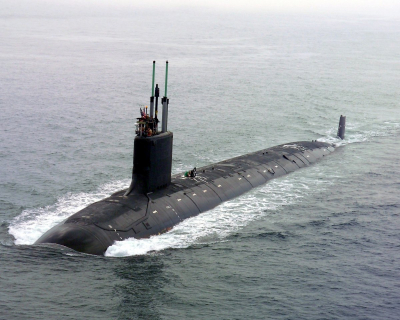Fort Stevens was an American military installation that guarded the mouth of the Columbia River in the state of Oregon. Built near the end of the American Civil War, it was named for a slain Civil War general and former Washington Territory governor, Isaac I. Stevens. The fort was an active military reservation from 18631947. It is now listed on the National Register of Historic Places.
Today the site is an Oregon state park just northwest of Warrenton.
A submarine (or sub) is a watercraft capable of independent operation underwater. It differs from a submersible, which has more limited underwater capability. The term is also sometimes used historically or colloquially to refer to remotely operated vehicles and robots, as well as medium-sized or smaller vessels, such as the midget submarine and the wet sub. Submarines are referred to as "boats" rather than "ships" irrespective of their size.Although experimental submarines had been built earlier, submarine design took off during the 19th century, and they were adopted by several navies. They were first widely used during World War I (1914–1918), and are now used in many navies, large and small. Military uses include attacking enemy surface ships (merchant and military) or other submarines, and for aircraft carrier protection, blockade running, nuclear deterrence, reconnaissance, conventional land attack (for example, using a cruise missile), and covert insertion of special forces. Civilian uses include marine science, salvage, exploration, and facility inspection and maintenance. Submarines can also be modified for specialized functions such as search-and-rescue missions and undersea cable repair. They are also used in tourism and undersea archaeology. Modern deep-diving submarines derive from the bathyscaphe, which evolved from the diving bell.
Most large submarines consist of a cylindrical body with hemispherical (or conical) ends and a vertical structure, usually located amidships, that houses communications and sensing devices as well as periscopes. In modern submarines, this structure is the "sail" in American usage and "fin" in European usage. A "conning tower" was a feature of earlier designs: a separate pressure hull above the main body of the boat that allowed the use of shorter periscopes. There is a propeller (or pump jet) at the rear, and various hydrodynamic control fins. Smaller, deep-diving, and specialty submarines may deviate significantly from this traditional design. Submarines dive and resurface by means of diving planes and changing the amount of water and air in ballast tanks to affect their buoyancy.
Submarines have one of the widest ranges of types and capabilities of any vessel. They range from small autonomous examples and one- or two-person subs that operate for a few hours, to vessels that can remain submerged for six months—such as the Russian Typhoon class, the biggest submarines ever built. Submarines can work at greater depths than are survivable or practical for human divers.

1942Jun, 21
World War II: A Japanese submarine surfaces near the Columbia River in Oregon, firing 17 shells at nearby Fort Stevens in one of only a handful of attacks by Japan against the United States mainland.
Choose Another Date
Events on 1942
- 25Jan
Thailand
World War II: Thailand declares war on the United States and United Kingdom. - 8Mar
Myanmar
World War II: Imperial Japanese Army forces captured Rangoon, Burma from British. - 10Jul
Soviet Union
Diplomatic relations between the Netherlands and the Soviet Union are established. - 13Aug
Manhattan Project
Major General Eugene Reybold of the U.S. Army Corps of Engineers authorizes the construction of facilities that would house the "Development of Substitute Materials" project, better known as the Manhattan Project. - 25Sep
Holocaust
World War II: Swiss Police instruction dictates that "Under current practice ... refugees on the grounds of race alone are not political refugees", effectively denying entry to Jews trying to flee occupied Europe during the Holocaust.

 English
English  español
español  français
français  português
português  русский
русский  العربية
العربية  简体中文
简体中文 